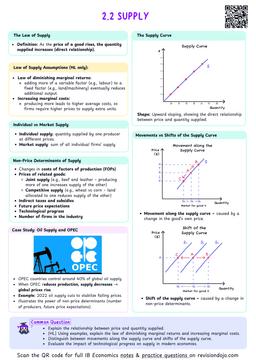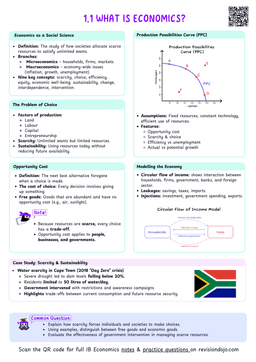Quota
Limit to the quantity of a certain good that can be imported over a particular period of time
Quotas have similar effects to tariffs, excluding the revenue generation for governments.
Quota Diagram
Trade Protection
When the government intervenes in international trade by imposing restrictions to reduce free imports.

Observing the diagram, before the quota, the economy is in free trade and operates at the world price $P_w$ which is below the domestic price $P_d$ that existed without free trade.
- The quantity supplied by domestic producers is $Q_1$ and quantity demanded by consumers is $Q_4$.
- The excess demand $Q_4 - Q_1$ is the initial quantity of imports.
- The government sets a quota, granting domestic producers more competitiveness as this causes imports of a limited quantity of foreign goods, denoted by $Q_3 - Q_2 = quota$.
- This creates a new supply curve $S_{d2}$ which is shifted to the right of $S_{d1}$ by the quantity of the quota imposed.
This new supply curve shows that the quantity that consumers can purchase at each price level is equal to the amount produced plus the quota.
- Therefore at $P_q$, even though the quantity domestic producers are willing to produce is $Q_2$, the imposition of the quota allows them to increase their supply by the limited amount of imports set by the quota ($Q_3 - Q_2 = quota$).
- Hence, with the new quota, the new domestic supply curve ($S_{d2}$) is met by the domestic demand curve $D_d$ at quantity $Q_3$ and price $P_q$ (price post-quota).
- So, even though domestic producers buy the foreign imports at $P_w$, they sell them at $P_q$. Hence, those domestic producers that have been awarded the quota licenses enjoy an extra revenue (quota revenue) equal to this difference in prices times the quantity imported $(P_q - P_w) \times (Q_3 - Q_2)$.
For the new supply curve, the price starts at the free world trade price of $P_w$ as it is the price at which producers buy imports (no producer will sell an imported good at a price lower at which they bought it).
As a result of the quota, at the new price $P_q$, the quantity supplied is $Q_3$ and the quantity demanded is $Q_3$. There is equilibrium.
Common MistakeThe price at which domestic producers buy the imported goods is still $P_w$.
However, due to the restricted limit on imports, the prices increase to $P_q$ to remove excess demand and the producers now will sell the goods at $P_q$ and earn higher profits.
The Effects of a Quota
The effects are almost identical to tariffs, except there is no revenue earned by the government.
Winners

Domestic Producers in possession of the quota licenses
- These domestic producers are supplying more ($Q_3$ instead of $Q_1$) at a higher price ($P_q$), earning higher revenues.
- Producer surplus increases by the area marked as $c$, indicating the gain from the new prices and trade restriction.
Producer surplus
The difference between the price sellers receive and the lowest price that they are willing and able to accept.
Workers
As domestic producers now produce and sell a larger quantity, the employment in the industry would be protected and increase as well.
Neutral
Unlike the tariff, the government doesn't earn revenue, but their budget isn't affected negatively either, leaving them neither better nor worse.
Losers
Consumers
- Consumers lose as they pay a higher price for the good ($P_q$).
- Hence, they can only purchase a lower quantity ($Q_3$ instead of $Q_4$).
- This causes the consumer surplus to fall by $c + d + e + f$.
Consumer surplus
The difference between the highest price consumers are willing and able to pay for a good or service and the actual price they end up paying.
Income Distribution
- Even though quotas do not involve a tax, the shift in price $P_q - P_w$ has the same effect upon the economy as the tax.
- Therefore, the price increase is regressive since it takes up a higher proportion of low-income individuals.
- This increases the disparity between incomes (3.4.9).
Inefficiency of Production
- The reason world price $P_w$ is smaller than domestic price without trade $P_d$ is because foreign producers are more efficient.
- The increase in quantity supplied from $Q_1$ to $Q_3$ represents the increase in domestic production that is inefficient as there is a waste of scarce resources by producing at $P_q$ instead of $P_w$.
Foreign Producers
- Foreign producers now supply fewer goods ($Q_4 - Q_3$ instead of $Q_2 - Q_1$), causing their quantity sold to decrease.
- However, the rise in price from quota could earn them extra revenues of $P_q - P_w$.
- Depending on which effect (the rise in price or import limit) is more impactful, they are either better or worse off.
Welfare Effects
The welfare effects are different to tariffs due to no government revenue.
Initially, before the quota is imposed:
- The producer surplus is the area marked by $g$ and the consumer surplus is the area marked by $a + b + c + d + e + f$.
- Thereby the social surplus was $a + b + c +d+e+f+g$.
Social surplus
The sum of consumer surplus and producer surplus. Maximised in the free market, when the market operates at its equilibrium point.
Remember:
- the producer surplus is the area below the price they earn and above the supply curve up till the quantity sold.
- the consumer surplus is the area above the price they pay and below the demand curve up till the quantity bought.
After the quota was imposed:
- The producer surplus increased by $c$ such that it is $c +g$ now.
- The consumer surplus fell by $c+d+e+f$ down to only $a+b$ now.
- Therefore the social surplus is $a + b + c +g$.
The change in social surplus is a decrease of: $$ a + b+c+d+e+f+g - (a+b+c+g) = d+f +e$$
This change leads to a welfare loss of the area $d+f+e$ due to the misallocation of resources where:
- The area $d$ welfare loss occurs due to inefficient production by domestic firms.


